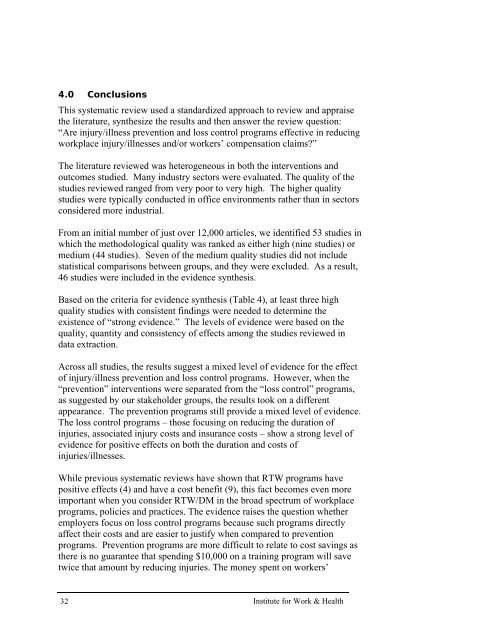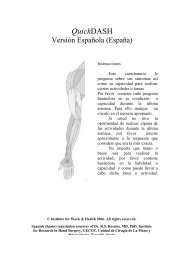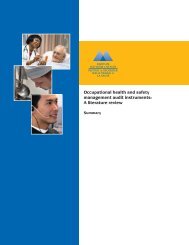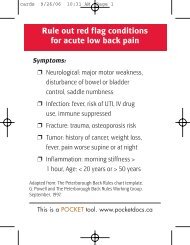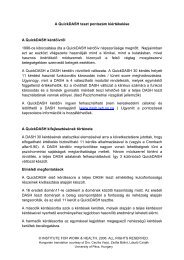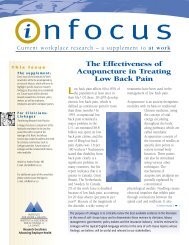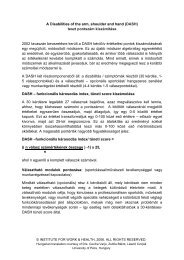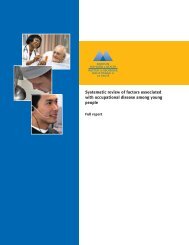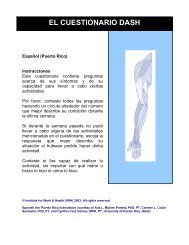A systematic review of injury/illness prevention and loss control ...
A systematic review of injury/illness prevention and loss control ...
A systematic review of injury/illness prevention and loss control ...
- No tags were found...
You also want an ePaper? Increase the reach of your titles
YUMPU automatically turns print PDFs into web optimized ePapers that Google loves.
4.0 ConclusionsThis <strong>systematic</strong> <strong>review</strong> used a st<strong>and</strong>ardized approach to <strong>review</strong> <strong>and</strong> appraisethe literature, synthesize the results <strong>and</strong> then answer the <strong>review</strong> question:“Are <strong>injury</strong>/<strong>illness</strong> <strong>prevention</strong> <strong>and</strong> <strong>loss</strong> <strong>control</strong> programs effective in reducingworkplace <strong>injury</strong>/<strong>illness</strong>es <strong>and</strong>/or workers’ compensation claims?”The literature <strong>review</strong>ed was heterogeneous in both the interventions <strong>and</strong>outcomes studied. Many industry sectors were evaluated. The quality <strong>of</strong> thestudies <strong>review</strong>ed ranged from very poor to very high. The higher qualitystudies were typically conducted in <strong>of</strong>fice environments rather than in sectorsconsidered more industrial.From an initial number <strong>of</strong> just over 12,000 articles, we identified 53 studies inwhich the methodological quality was ranked as either high (nine studies) ormedium (44 studies). Seven <strong>of</strong> the medium quality studies did not includestatistical comparisons between groups, <strong>and</strong> they were excluded. As a result,46 studies were included in the evidence synthesis.Based on the criteria for evidence synthesis (Table 4), at least three highquality studies with consistent findings were needed to determine theexistence <strong>of</strong> “strong evidence.” The levels <strong>of</strong> evidence were based on thequality, quantity <strong>and</strong> consistency <strong>of</strong> effects among the studies <strong>review</strong>ed indata extraction.Across all studies, the results suggest a mixed level <strong>of</strong> evidence for the effect<strong>of</strong> <strong>injury</strong>/<strong>illness</strong> <strong>prevention</strong> <strong>and</strong> <strong>loss</strong> <strong>control</strong> programs. However, when the“<strong>prevention</strong>” interventions were separated from the “<strong>loss</strong> <strong>control</strong>” programs,as suggested by our stakeholder groups, the results took on a differentappearance. The <strong>prevention</strong> programs still provide a mixed level <strong>of</strong> evidence.The <strong>loss</strong> <strong>control</strong> programs – those focusing on reducing the duration <strong>of</strong>injuries, associated <strong>injury</strong> costs <strong>and</strong> insurance costs – show a strong level <strong>of</strong>evidence for positive effects on both the duration <strong>and</strong> costs <strong>of</strong>injuries/<strong>illness</strong>es.While previous <strong>systematic</strong> <strong>review</strong>s have shown that RTW programs havepositive effects (4) <strong>and</strong> have a cost benefit (9), this fact becomes even moreimportant when you consider RTW/DM in the broad spectrum <strong>of</strong> workplaceprograms, policies <strong>and</strong> practices. The evidence raises the question whetheremployers focus on <strong>loss</strong> <strong>control</strong> programs because such programs directlyaffect their costs <strong>and</strong> are easier to justify when compared to <strong>prevention</strong>programs. Prevention programs are more difficult to relate to cost savings asthere is no guarantee that spending $10,000 on a training program will savetwice that amount by reducing injuries. The money spent on workers’32 Institute for Work & Health


